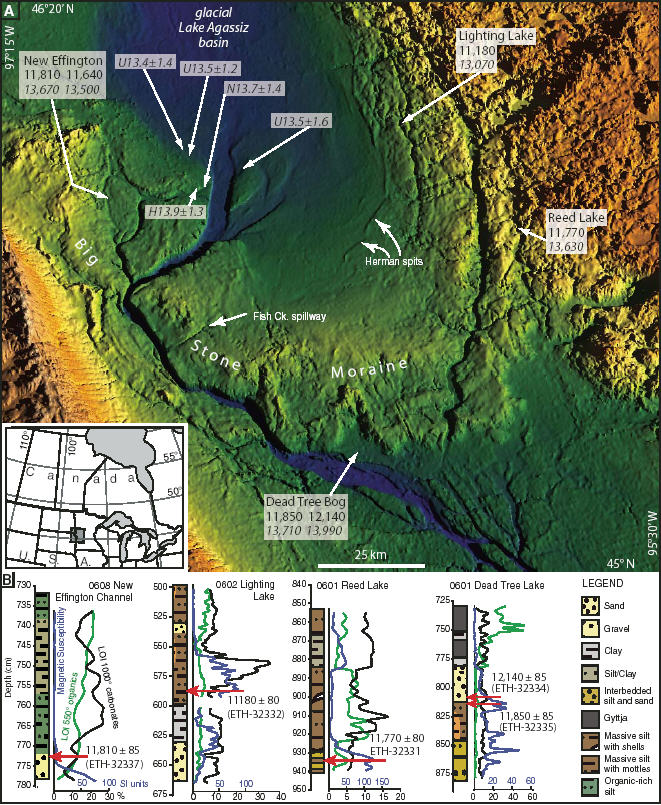On October 10th, not far from the ancient shore of Lake Agassiz, University of Cincinnati Professor of Geology Thomas Lowell will present a paper about the lake to the Geological Society of America annual meeting in Minneapolis. Although Lake Agassiz is gone, questions about its origin and disappearance remain. Answers to those questions may provide clues to our future climate. One question involves Lake Agassiz' role in a thousand-year cold snap known as the Younger Dryas.
As the last ice age ended, thousands of years of warming temperatures were interrupted by an abrupt shift to cold. Tundra conditions expanded southward, to cover the land exposed as the forests retreated. This colder climate is marked in the fossil record by a flowering plant known as Dryas, which gives the period its name.

From: The Mystery Of The Lake That Triggered Global Warming. Shaded relief map of Big Stone Moraine and study sites. View is oblique from the south with sun angle from the southeast. Core sites, optically stimulated luminescence sites, and results are shown. For cores sites, upper age is the corrected radiocarbon age and lower italicized age is the calibrated age. Site details are in Data Repository Tables DR1 and DR2
"My work focuses on abrupt or rapid climate change," Lowell said. "The Younger Dryas offers an opportunity to study such change. The climate then went from warming to cooling very rapidly, in less than 30 years or so."
Scientists noted that the Younger Dryas cold spell seemed to coincide with lower water levels in Lake Agassiz. Had the lake drained? And, if so, had the fresh water of the lake caused this climate change by disrupting ocean currents? This is the view of many scientists, Lowell said.
Lowell investigated a long-standing mystery involving Lake Agassiz -- a significant drop in water level known as the Moorhead Low. It has long been believed that the Moorehead Low when water drained from Lake Agassiz through a new drainage pathway. Could this drainage have flowed through the St. Lawrence Seaway into the North Atlantic Ocean?
"The most common hypothesis for catastrophic lowering is a change in drainage pathways," Lowell said. The problem is, better dating of lake levels and associated organic materials do not support a rapid outflow at the right time. "An alternative explanation is needed," he said.
Lowell's research shows that, although water levels did drop, the surface area of the lake increased more than seven-fold at the same time. His research suggests that the lower water levels were caused by increased evaporation, not outflow. While the melting glacier produced a lot of water, Lowell notes that the Moorhead Low was roughly contemporaneous with the Younger Dryas cold interval, when the atmosphere was drier and there was increased solar radiation.
"The dry air would reduce rainfall and enhance evaporation," Lowell said. "The cold would reduce meltwater production, and shortwave radiation would enhance evaporation when the lake was not frozen and sublimation when the lake was ice-covered."
Further research will attempt a clearer picture of this ancient episode, but researchers will have to incorporate various factors including humidity, yearly duration of lake ice, annual temperature, and a better understanding of how and where meltwater flowed from the receding glaciers.
Lowell's efforts to understand changes in ancient climates have taken him from Alaska to Peru, throughout northern Canada and Greenland. In Greenland, Lowell and a team of graduate students pulled cores of sediment from lakes that are still ice-covered for most of the year. Buried in those sediments are clues to long-ago climate.
"We look at the mineralogy of the sediments," Lowell said, "and also the chironomids. They're a type of midge and they're very temperature sensitive. The exact species and the abundance of midges in our cores can help pinpoint temperature when these sediments were deposited."






Comments